Martina Franca
Ostuni
- Origins of Ostuni
- What to see in Ostuni
- Events in Ostuni
- Practicalities
- Seaside of Ostuni
- Masserie of Ostuni
- Trulli
- Museum of Ostuni
- Parks and protected areas
- Cuisine
- Images of Ostuni
- Ostuni local info
- Getting to Ostuni
Rentals
Services
- Property and land management
- Guest management
- Property restoration and reparing works
- Taxi service and taxi sharing service
- Services for disabled
Excursions
Food & Wine
Martina Franca and its Baroque palaces
Martina Franca is an Apulian town located on the South Eastern part of the Murgia hills at a height of 431 meters above sea level. The town faces the Itria Valley, a green countryside dotted with 'trulli' and ancient farms called 'masserie' typical of the area.
The origins of Martina Franca go back to the beginning of the 14th century, when, some refugees fled here from the city of Taranto because of the continuous raids by the Saracens.
The old town of Martina Franca is a splendid example of Baroque art with palaces and churches that can be appreciated walking through its narrow streets.
Ufficio Informazioni Turistiche
Indirizzo: Piazza Roma, 35
Telefono: +39 080 480 5702
Distance from Ostuni: 24 km
Time to get there by car: about 30 minutes
Places in Puglia: Martina Franca
Get this fully comprehensive guide to enjoy the art and life in Martina Franca.
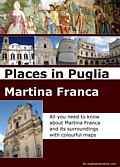
What's inside: history of Martina Franca and its monuments to visit: churches, palaces, defensive towers and gates. The territory: masserie, nature reserve and archeological sites. La dolce vita in Martina Franca with the best restaurants, pubs, bars and night bars. Uselful info and praticalities. Plus 4 useful maps.
Ebook for Kindle, Ipad, Iphone, all smartphones, Tablets, PCs and Macs.
Get it from Amazon.co.uk
Get it from Amazon.com
What to see in Martina Franca
Basilica di San Martino
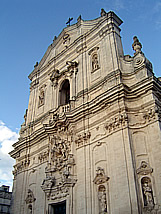
The Basilica of Martina Franca was built between 1747 and 1767. It has a façade in Rococo style with a portal decorated by high-relief sculptures of Saint Martin and the poor.
Its front is 37 meters high on a base of 24 meters. It was built with local limestone and it is divided, horizontally, into two orders, and, vertically by bands of pilasters with capitals.
Inside there are some rich marble altars, a pulpit carved by Domenico Semeraro and a 'Last supper' painting by Carella.
Palazzo dell'Università
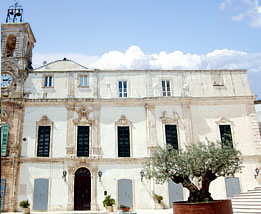
During the medieval period was called 'Università' the place where all citizens of the town, with equal rights and no social distinctions, gathered to discuss about public problems. This was a fundamental political institution that in 1478 Ferdinand of Aragon, King of Naples, granted to the people of Martina Franca to ensure fair administration of the resources of the city. The palace was built in the seventeenth century, although the last floor was only added in the 1827.
Torre Civica

This tower stands attached to the palazzo dell'Università. It is a square shaped tower on four levels, each with different architectural and decorative features.
The ground floor is bordered by columns and rounded corners. The first floor has a pair of pilasters and a central balcony. On the entablature, under the eardrum, there is a Latin inscription with the name of the mayor, the creator of the work.
Palazzo Ducale
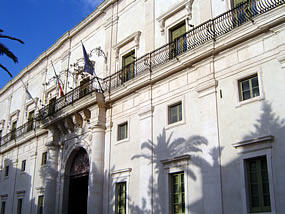
This palace, built by Petraccone V Caracciolo in 1669, houses the Town Council, a town library and the "Paolo Grassi" musical and artistic centre that every year, since 1974, organises the Festival della Valle d'Itria, one of the most popular opera festivals in Italy.
Many rooms are occupied by municipal offices therefore can not be visited. There are, however, accessible rooms such as the Ducal Chapel and the Rooms of the Arcadia, the Myth and the Bible.
The Ducal Chapel was painted by Domenico Carella in 1776 and the Arcadia rooms were inspired by the 17th century cultural movement that spread throughout Italy as an alternative stylistic exuberance to the wonders of the Baroque.
Palazzo Martucci
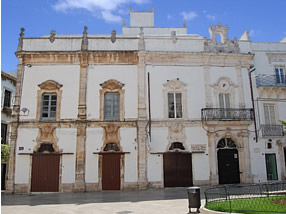
Palace Martucci has a prospect perfectly defined and balanced. The façade has a portal and mixlinear windows both in the lower and higher order.
The main entrance offers the usual pattern of the baroque of Martina Franca such as the main portal in line with the above balcony. This longitudinal development of the module portal-balcony is more accentuated by the placement of a pierced and decorated cornice.
Piazza Maria Immacolata anche chiamata Portici
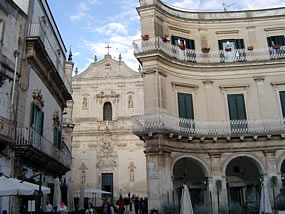
Piazza Maria Immacolata, better known by the name of Portici, fits harmoniously between Piazza Plebiscito, dominated by the Rococo lines of the Basilica of San Martino and via Cavour, dominated by the magnificent creativity of Baroque palaces.
The semi-elliptical corner of the square creates a cosy and elegant place. It was built in 1854 by David Conversano for initiative of a priest, Giacomo Fedele, who commissioned at his own expense the realization of a public citizen intended to mercantile activities.
He conceived a semicircular piazza with a succession of 13 consecutive deep arches that would accommodate various stalls and vendors, becoming in effect the business forum of the old town. It had this use until the early '60 of the 20th century.
Palazzo Stabile
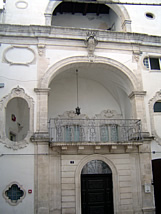
Palazzo Stabile is the result of a transformation of a regular house into a palace. In fact, the wall of the ground floor, in smooth ashlar, which supports the railing of the first floor, was built in the 19th century to conceal the entrance hall and the stairs leading to the main floor, slightly raised above the floor of the road.
The façade has symmetrical decorative elements, such as oval windows with 18th century frames.
Palazzo Blasi
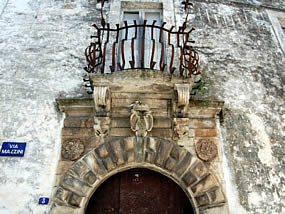
Palazzo Blasi, built by the Blasi family, is located near the ancient city door of San Nicola (via Mazzini), now known as San Francesco, and at the beginning of one of the most charming baroque roads of Martina Franca: via Mazzini.
The construction of this building dates back to the second half of the 18th century (1774) and is characterized by a late-Renaissance style portal. Its façade has only a small balcony on its left but three on its right.
Other interesting palaces located in via Mazzini:
Palazzo Montemurro Marinosci (Via Mazzini, 10)
Palazzo del Cavalier Semeraro (Via Mazzini, 16)
Palazzo Barnaba (Via Mazzini, 24)
Palazzo Fighera Calucci (Via Mazzini, 33-36)
Other palaces to see in Martina
Palazzo Casavola ora Marinosci (Via Cavour, 18 )
Palazzo Maglia/Lella (Via Cavour, 25)
Palazzo Fanelli ora Torricella (Via Cavour, 30)
Palazzo Lopez/Monghelli (Largo Ignazio Ciaia)
Palazzo Domenico Motolese (via Principe Umberto, 61)
Palazzo Magli Caroli (Via Pietro Cossa, 3)
Palazzo Casavola/Ancona (Via Buonarroti, 15)
Palazzo Delfini (Via Machiavelli, 2)
Palazzo Ancona (Via Machiavelli, 7)
Ospedaletto (Via Orfanelli, 5 )
Palazzo Maggi (Largo San Pietro, 6)
Palazzo Recupero/Magno (Via Cirillo, 4)
Palazzo Simeone (Via Paolo Chiara, 6)
Ostuni
- Origins of Ostuni
- What to see in Ostuni
- Events in Ostuni
- Practicalities
- Seaside of Ostuni
- Masserie of Ostuni
- Trulli
- Museum of Ostuni
- Parks and protected areas
- Cuisine
- Images of Ostuni
- Ostuni local info
- Getting to Ostuni
Rentals
Services
- Property and land management
- Guest management
- Property restoration and reparing works
- Taxi service and taxi sharing service
- Services for disabled
Excursions
Food & Wine







